Introduction
The Nikon D3200 is an entry-level digital SLR camera boasting a newly designed 24.2 megapixel DX format APS-C sensor and the same EXPEED 3 processor as the flagship D4 DSLR. The D3200 also boasts a 3 inch 921k-dot LCD monitor, one-touch full 1080p HD video recording with autofocus, quick-access Live View mode, ISO range of 100-12800, 11-point autofocus system, 4fps continuous shooting and the latest-generation interactive Guide Mode. The Nikon D3200 is available in black or red priced at £559.99 / €667.00 body only and £649.99 / €775.00 / $699.95 with the Nikkor 18-55mm VR lens.
Ease of Use
Like the 18-month old D3100, the new Nikon D3200 is a rather small DSLR camera, although it does come with a chunky right-hand grip that makes it better suited to hand-held shooting than some of its competitors. Still, expect having to find a place for your little finger under the camera if you have larger-than-average hands. The camera body itself is mainly plastic, but while the D3200 certainly doesn't feel as robust as some of the company's higher specified models, it still exudes a degree of quality you might not expect at this price point. This is helped by the surprisingly classy rubber coating on the grip, which also appears on the thumb rest on the back of the camera.
The Nikon D3200's body is almost identical to its predecessor in terms of the overall dimensions and weight, with most external controls in the same places as before. Notable changes to the outside of the camera include the inclusion of an infrared remote sensor in the grip and rear of the D3200, which now accepts both an infrared release and a wired remote release cable, and the use of a simple button to take you to Live View mode rather than the D3100's more fiddly spring-loaded lever. There's also the unwelcome removal of the D3100's drive-mode lever at the top, which we loved because it made setting and checking the current drive mode very easy and straightforward, and the logical relocation of the small red button that acts as a movie shutter release, enabling one-touch video recording when you are in Live View, from the rear to the top of the camera next to the main shutter release button.
The 18-55mm f/3.5-5.6 VR kit lens that Nikon supplied feels fairly well-balanced - if a tad front-heavy - on the Nikon D3200 and it fits into place with a reassuring mechanical click. It also adds the very important advantage of Vibration Reduction. Nikon bodies don't offer any form of in-camera image stabilisation, unlike similar models from Sony, Pentax and Olympus, so the affordable 18-55mm VR lens is a good partner for the D3200.
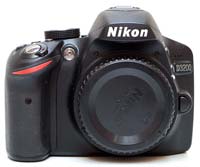 | 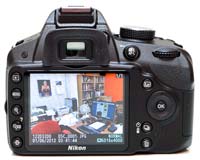 |
| Front | Rear |
The Nikon D3200 follows conventional DSLR design in having a shooting mode dial on the top of the camera, which allows you to select either one of the advanced modes like Manual, Aperture- or Shutter-priority, or a number of scene modes.
The Guide mode first seen in the D3000 has also been carried over, and enhanced to include sample images to help you to identify the shot. Also new options have been added to the Advanced operation menu, for example to help you to reduce blur or soften backgrounds. The main purpose of the Guide mode remains the same as on the D3000 and D3100, namely to teach beginners about what settings to use in a number of shooting situations, and how these settings influence the final output. We feel that Nikon deserves kudos for this, as a mode like this can teach beginners a lot more about the basics of photography than the green Auto mode in which the camera assumes control of almost everything.
The Exposure Compensation button is thoughtfully positioned next to the shutter release. Hold down this button with your right forefinger and spin the control wheel on the top-rear of the camera with your thumb to adjust its settings - simple and intuitive. In M mode, this easy-to-reach button allows you to toggle between aperture and shutter speed settings, making the lack of a second control wheel less problematic.
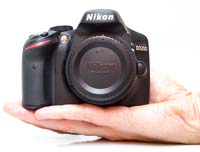 | 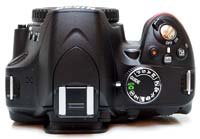 |
| Front |
Top
|
The second button sitting next to the shutter release, labelled 'info', is arguably at the heart of the Nikon D3200's ease-of-use, as the camera lacks the monochromatic status LCD of more expensive models like the D7000, so Nikon had to provide a different way to check vital shooting information without having to look into the viewfinder. Enter the info button - pressing it displays virtually all of the camera's main settings on the large, high resolution rear screen.
The same screen is used for the D3200's Live View and movie recording modes. As noted above, the Nikon D3200 has a small button on the back which makes entering Live View a very easy and simple affair. In Live View the camera autofocuses using the contrast detect method. Depending on the AF mode set, you can either initiate this via a half-press of the shutter release, or have the camera keep focusing continuously. The first method is noticeably faster than on earlier models, though still not nearly as quick as the phase detection method used outside Live View. The other autofocus mode, called full-time AF, can be more of an annoyance than a benefit, as the picture might go out of focus just before you wanted to take a shot (though you can at least lock focus by half-pressing the shutter release when you think focus is where it should be).
Of course you can also focus manually while in Live View mode. As with earlier LV-enabled models, it is possible to magnify into the live image by repeatedly pressing the button labelled with a loupe icon - however, due to what appears to be a lo-res live view feed, this magnification is not much help. On a related note, it's also annoying that Nikon still doesn't offer a live histogram to help you get the exposure right when working in Live View mode.
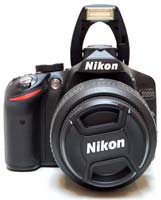 |  |
| Pop-up Flash | Side |
The Nikon D3200 features a 1080p Full HD “D-movie” mode. At the highest resolution setting, the camera can record movies at cine standard 24fps, while at 1280x720 pixels you can choose from 24, 25 or 30 frames per second. The Nikon D3200 offers full-time autofocus in movie mode, but you may quickly decide to turn this feature off. For one thing, the sound of the focus motor in the lens gets picked up by the microphone. For another, the subject may go out of focus for no apparent reason. If you really want to make sure an erratically moving subject stays sharp throughout the clip, you had better stop down the lens for enough depth of field to work with, and leave all shallow-depth-of-field trickery to static or predictably moving subjects.
With the Nikon D3200, there is now an element of exposure control when shooting movies. Both the aperture and the shutter speed can be pre-set before you start filming and changed whilst shooting, a welcome boon to your creativity. By default, exposure changes with subject luminance while capturing a clip, although you can at least lock exposure by holding down the AE Lock button. The camera does not provide any special feedback on focus or highlight blow-out (i.e. no “peaking” or “zebras” like in professional video cameras), but there is now manual control over audio levels and sound is recorded by way of the built-in stereo microphone. You can also hook the D3200 up an optional external stereo mic to improve the audio quality. Videos are compressed using the H.264 codec and stored in a MOV container. Movie quality is, thankfully, good with excellent resolution and good dynamic range, although your footage may suffer from various “rolling shutter” effects when doing quick pans or shooting hand-held with a telephoto lens.
Like all SLRs, the D3200 has a proper through-the-lens optical viewfinder. It's not as large as that of a D7000, for example, but you wouldn't expect it to be at this price point anyway. The positions of the 11 autofocus sensors are permanently but unobtrusively marked on the focusing screen with 11 tiny dots. In single-point AF mode - in which you can specify which AF point the camera should use - the active autofocus point lights up in red upon a half-press of the shutter release. The other available AF area modes include Auto Area, Dynamic Area and 3D Tracking. Autofocus speeds with the kit zoom weren't stellar, but focusing with the optical viewfinder was still a lot faster than in Live View mode. Focus accuracy left a bit to be desired, especially when using one of the off-centre focus points (AF point selection is done by way of the four-way pad, a simple and intuitive solution.)
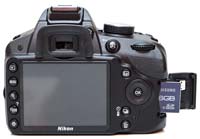 | 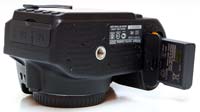 |
| Memory Card Slot | Battery Compartment |
Just like most other entry-level Nikon dSLRs, the Nikon D3200 lacks a body-integral focus motor, so it can only autofocus with AF-S and AF-I lenses which have the AF motor built in. Other AF Nikkors can be used in manual-focus mode only, although the AF sensors remain active and can at least provide focus confirmation via the green dot in the in-finder LCD. There is also an “electronic rangefinder” function that can be enabled via the menu; this tells you how far you are from perfect focus, and which way you need to rotate the focus ring to acquire it. Manual-focus AI and AI-s lenses without a CPU can only be used in M mode, and the camera will refuse to provide any form of metering, so you will either have to use an external meter or take a few test shots to determine the optimal exposure. Focus confirmation, however, works with these lenses too, via the green dot; albeit the afore-mentioned “electronic rangefinder” functionality is disabled. One interesting thing we found is that if you shoot a D-movie using a non-CPU lens, the camera will adjust exposure normally, so the lack of metering only applies to stills.
For the images already captured, the Nikon D3200 offers a broad range of retouching tools, including post-capture D-lighting (useful if you forgot to turn on Active D-lighting before capture), red-eye correction, trimming, monochrome conversion, different filter effects, colour balancing, image resizing, image overlay, in-camera raw processing, distortion correction, and a miniature effect that mimics a look that can otherwise only be achieved with a tilt lens. Many of these functions make it unnecessary to buy specialised computer programs or plug-ins and spend hours in front of a computer to achieve a desired/popular effect.
The Nikon D3200 is powered by a proprietary Lithium-ion battery and ships with a cordless charger that plugs directly into a mains socket. For storage, the camera uses SD, SDHC and SDXC memory cards. As far as connectivity goes, there are A/V Out, mini HDMI and USB terminals, a proprietary connector for an optional cable release or GPS unit, and the already mentioned external microphone socket.
This concludes our evaluation of the Nikon D3200's ergonomics, handling and features. Let's now move on to that all-important aspect of a digital SLR camera - image quality.








0 comments:
Post a Comment